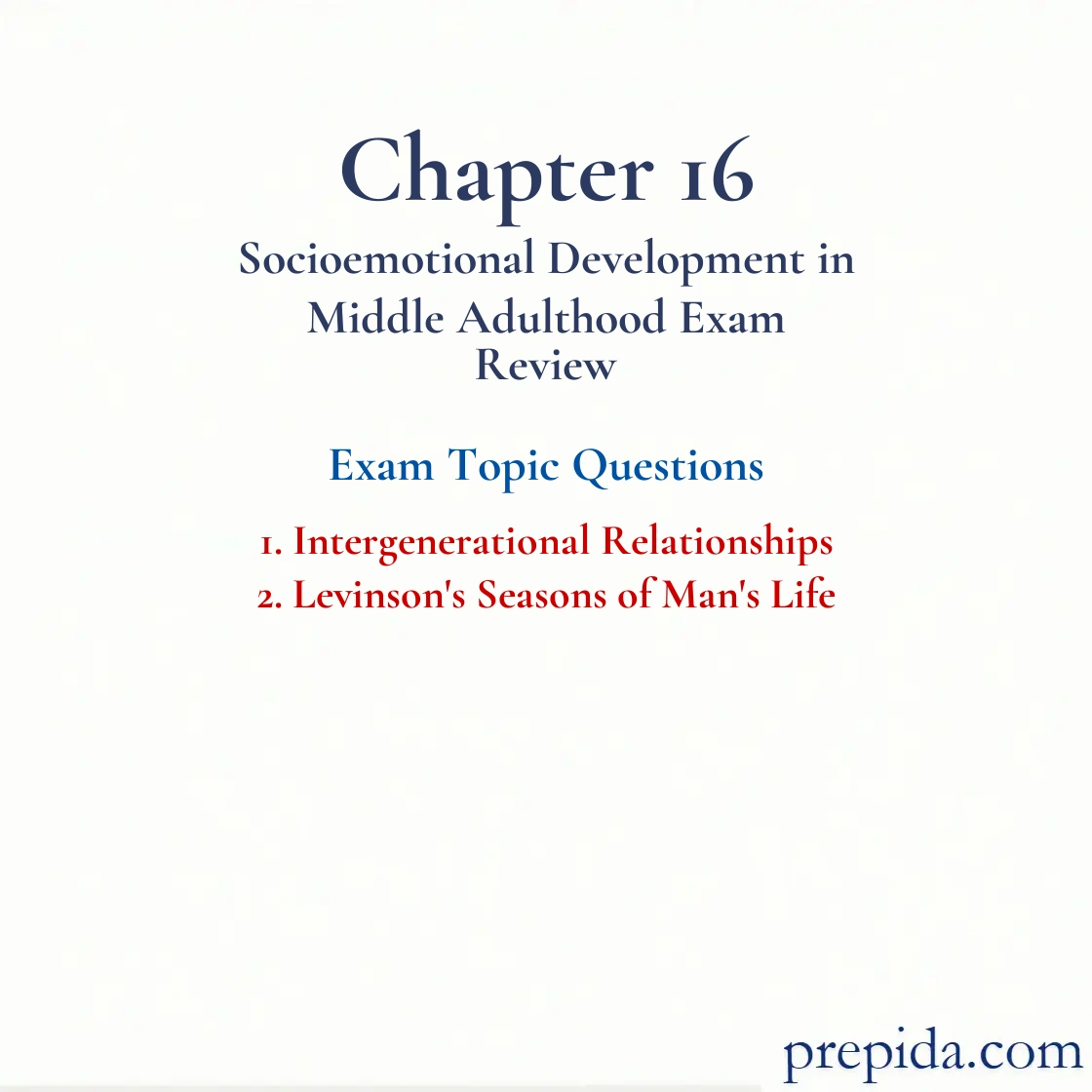
Middle adulthood is referred to as the sandwich generation because
- life is very hectic and families rarely have a full meal together.
- people expect middle-aged adults to be both wise and mature as well as young and energetic.
- middle-aged adults are caught in a conflict between caring more for their spouse's parents than their own.
- middle-aged adults may have to care for their own adolescent children as well as their elderly parents.
Middle Adulthood: The developmental period that begins at approximately 40 to 45 years of age and extends to about 60 to 65 years of age.
According to research on intergenerational relationships, in which of the following ways is an adult child most likely to be similar to his or her parents?
- in politics
- in lifestyle
- in gender roles
- in work orientation
According to research by Rossi, who among the following were found to have the closest relationships during their adult years?
- fathers and sons
- mothers and sons
- fathers and daughters
- mothers and daughters
In the context of intergenerational relationships, which of the following is a finding of a study by Rossi?
- Fathers and their sons have a much closer relationship during their adult years than fathers and daughters.
- Men's relationships across generations are typically closer than other family bonds.
- Fathers' intergenerational ties are more influential for grandparent-grandchild relationships than mothers'.
- Married men are more involved with their wives' kin than with their own.
Which of the following statements is true of intergenerational relationships?
- Individuals who had conflicts with their parents in adolescence reported greater closeness with their parents in early adulthood.
- A similarity between parents and an adult child is most noticeable in religion and politics.
- Children who spent less time in shared activities with their parents earlier in their lives provided more support to their parents as they became older.
- Parents who were regular smokers earlier were less likely to have adolescents who became smokers.
Religion: An organized set of beliefs, practices, rituals, and symbols that increases an individual’s connection to a sacred or transcendent other (God, higher power, or higher truth).
According to Levinson, the transition to middle adulthood requires the adult male come to grips with four major conflicts. Which of the following is one of the major conflicts?
- being young versus being old
- being attractive versus being unattractive
- being extroverted versus being introverted
- being married versus being single
Middle Adulthood: The developmental period that begins at approximately 40 to 45 years of age and extends to about 60 to 65 years of age.
According to Levinson, the transition to middle adulthood requires the adult male come to grips with four major conflicts. One of the major conflicts is
- being married versus being single.
- being attractive versus being unattractive.
- being destructive versus being constructive.
- being extroverted versus being introverted
Middle Adulthood: The developmental period that begins at approximately 40 to 45 years of age and extends to about 60 to 65 years of age.
According to Levinson, identify a major task that must be mastered in early adulthood.
- reaching the pinnacle of one's career
- developing a stable life structure
- focusing on family development
- forming an image of one's career
Identity Achievement: Marcia’s term for the status of individuals who have undergone a crisis and have made a commitment.
Kyle just celebrated his 40th birthday. According to Levinson, Kyle has
- reached a stable point in his career.
- just started to determine his goals.
- just formed a dream about his future.
- just started his career and is focused.
From about the ages of 28 to 33, a man goes through a transition period in which he must face the more serious question of
- achieving his independence.
- forming his dreams.
- achieving his goals.
- determining his goals.
Identity Achievement: Marcia’s term for the status of individuals who have undergone a crisis and have made a commitment.
According to Levinson, the transition from dependence to independence is marked by the
- realization of a goal.
- testing of a dream.
- free experimentation of a dream.
- formation of a dream.
According to Levinson, which of the following is a major task that needs to be mastered in early adulthood?
- exploring the possibilities for adult living
- determining one's goals in life
- testing one's dreams in the real world
- becoming independent
According to Levinson, the ________ rests on how effectively an individual reduces the polarities and accepts each of them as an integral part of his or her being.
- failure of adolescent transition
- success of the midlife transition
- success of transition into early adulthood
- success of transition into late adulthood
Jensen is 25 years old, and he will be starting his career as a business analyst. According to Levinson, Jensen is in the ________ phase of adult development.
- stagnant
- novice
- expert
- generative
What did Levinson's research conclude about women in midlife transition?
- Women have significantly less distress during this process.
- Women face the midlife transition earlier and with greater difficulty than do men.
- Women who have children experience an easier time during midlife than those who do not have children.
- Levinson reported that his stages, transitions, and the crisis of middle age hold for women as well as men.
Crisis: Marcia’s term for a period of identity development during which the adolescent is exploring alternatives.
According to Levinson, the transition to middle adulthood lasts about ________ years.
- 2
- 4
- 5
- 7
According to Levinson, which of the following should occur at the end of one's teens?
- a transition from dependence to independence
- an increase in generativity
- an increase in feelings of stagnation
- a transition from conventional to postconventional reasoning